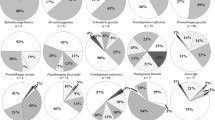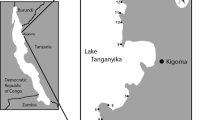Abstract
We studied benthic harpacticoid grazing on diatom algae from two sites on the White Sea intertidal sandflat. Diatoms from sediments and from harpacticoid gut contents were sampled in situ, identified and counted, and grazing rates were calculated by two ways: (1) using potential daily ration estimations and (2) from the gut content and gut-residence time data. Paraleptastacus kliei did not contain any diatoms in the guts and presumably fed on other objects (bacteria or flagellates). Two other dominating species studied, Heterolaophonte minuta and Huntemannia jadensis, contained an average of 604 and 222 diatom cells per specimen. Diet composition differed significantly from the natural algal community. Two diatoms of intermediate cell size (Nitzschia palea var. debilis and Navicula sp.) contributed 92–97% of gut content for H. minuta and 58–81% for Hn. jadensis, whereas these diatoms amounted to only about 10% of biomass in native community. Mean consumption rates were estimated as 50–200 μg of wet biomass/day/cm2, so the harpacticoids grazed only between 3 and 11% of the total microalgae biomass per day. The grazing impact on the two preferred diatom populations, however, was much more intensive, 10–30% per day for Navicula sp. and 55–228% for N. palea. Therefore, native harpacticoid populations demonstrate highly selective feeding and could be strongly limited by their food in spite of seemingly plentiful total abundance of microphytobenthos. This disproportionally high grazing pressure upon some species apparently could affect the structure of microalgae communities resulting in low relative abundance of mid-sized forms. We hypothesize that a very dynamic spatio-temporal distribution of epibenthic harpacticoids (short-living micropatches) may be the possible adaptation to such local food limitation.



Similar content being viewed by others
References
Abolmasova GI (1976) Feeding and the elements of energy balance of Gammarus olivii M.-Edw. From the Blask Sea (in Russian). Biologija Morja (Kiev) 37:41–45
Abu-Rezq TS, Yule AB, Teng SK (1997) Ingestion, fecundity, growth rates and culture of the harpacticoid copepod, Tisbe furcata, in the laboratory. Hydrobiologia 347:109—118
Admiraal W, Bouwman LA, Hoekstra L, Romeyn K (1983) Qualitative and quantitative interactions between microphytobenthos and herbivorous meiofauna on a brackish intertidal mudflat. Int Revue Ges Hydrobiol 68:175–191
Armonies W (1989) Meiofauna emergence from intertidal sediment measured in the field: significant contribution to nocturnal planktonic biomass in shallow water. Mar Ecol Prog Ser 43:29–43
Azovsky AI, Chertoprood ES (2003) Spatio-temporal dynamics of the White Sea littoral harpacticoid community. Oceanology 43:103–111
Azovsky AI, Chertoprood ES, Saburova MA, Polikarpov IG (2004) Spatio-temporal variability of micro- and meiobenthic communities in the White Sea intertidal sandflat. Est Coast Shelf Sci 60:663–671
Bascompte J, Solè RV (1995) Rethinking complexity: modelling spatiotemporal dynamics in ecology. Trends Ecol Evol 10:361–366
Bauer JE, Montagna PA, Spies RB, Prieto MC, Hardin D (1988) Microbial biogeochemistry and heterotrophy in sediments of a marine hydrocarbon seep. Limnol Oceanogr 33:1493–1513
Blanchard GF (1990) Overlapping microscale dispersion patterns of meiofauna and microphytobenthos. Mar Ecol Prog Ser 68:101–111
Blanchard GF (1991) Measurement of meiofauna grazing rates on microphytobenthos: Is primary production a limiting factor? J Exp Mar Biol Ecol 147:37–46
Brown TJ, Siebert JR (1977) Food of some benthic harpacticoid copepods. J Fish Res Bd Can 34:1028–1031
Buffan-Dubau E, Carman KR (2000) Diel feeding behavior of meiofauna and their relationships with microalgal resources. Limnol Oceanogr 45:381–395
Burkovsky IV (1992) Structural and functional organization and stability of marine benthic communities (in Russian). Moscow State University Press, Moscow
Carman KR (1990a) Mechanisms of uptake of radioactive labels by meiobenthic copepods during grazing experiments. Mar Ecol Prog Ser 68:71–83
Carman KR (1990b) Radioactive labeling of a natural assemblage of marine sedimentary bacteria and microalgae for trophic studies: an autoradiographic study. Microb Ecol 19:279–290
Carman KR, Thistle D (1985) Microbial food partitioning by three species of benthic copepods. Mar Biol 88:143–148
Carman KR, Dobbs FC, Guckert JB (1989) Comparison of three techniques for administering radiolabeled substrates to sediments for trophic studies: Uptake of label by harpacticoid copepods. Mar Biol 102:119–125
Carman KR, Fleeger JW, Pomarico SM (1997) Response of a benthic food web to hydrocarbon contamination. Limnol Oceanogr 42:561–571
Chandler GT, Fleeger JW (1984) Tube-building by a marine meiobenthic harpacticoid copepod. Mar Biol 82:15–19
Chepurnov VA (1987) On the role of benthic diatom algae in feeding of harpacticoids (Copepoda) (in Russian). Zoologicheskiy Zhurnal 66(7):1005–1012
Chepurnov VA (1988) Benthic diatom algae and harpacticoids of the Black Sea shallow waters near the Karadag and their trophic relations (in Russian). PhD Thesis. Institute of biology of southern seas
Chertoprood ES, Azovsky AI (2005) Seasonal population dynamics of the White Sea littoral harpacticoids (Harpacticoida: Copepoda). Oceanology 45 (in press)
Chislenko LL (1968) Nomograms for weight estimation of water organisms by their body size and form (in Russian). Nauka, Leningrad, 105 pp
Decho AW (1986) Water-cover influences on diatom ingestion rates by meiobenthic copepods. Mar Ecol Prog Ser 33:139–146
Decho AW, Castenholz RW (1986) Spatial patterns and feeding of meiobenthic harpacticoid copepods to resident microbial flora. Hydrobiologia 131:87–96
Decho AW, Fleeger JW (1988) Microscale dispersion of meiobenthic copepods in response to food-resource patchiness. J Exp Mar Biol Ecol 118:229–243
Foreman K, Valiela I, Sarda R (1995) Controls of benthic marine food webs. Sci Mar 59(suppl 1):119–128
Frost BW (1972) Effects of size and concentration of food particles on the feeding behavior of the marine planktonic copepod Calanus pacificus. Limnol Oceanogr 17:805–815
Gee JM, Warwick RM (1984) Preliminary observations on the metabolic and reproductive strategies of harpacticoid copepods from an intertidal sandflat. Hydrobiology 118:29–37
Gruzov LN (1986a) Onthogenetic ration changes of some representatives of the family Calanidae (Copepoda) consuming food of various size (in Russian). Oceanology 26(4):684–690
Gruzov LN (1986b) “Supporting” concentration of food and its possible calculation according to age and ecological characteristics of some species of Calanidae family (Copepoda) (in Russian). Oceanology 26(5):824–830
Guthrie CG, Moorhead DL (2002) Density-dependent habitat selection: evaluating isoleg theory with a Lotka-Volterra model. Oikos 97:184–194
Hanski I, Ovaskainen O (2000) The metapopulation capacity of fragmented landscapes. Nature 404:755–758
Hicks GR (1988) Evolutionary implications of swimming behavior in meiobenthic copepods. Hydrobiologia 167/168:497–504
Hicks GR, Coull BC (1983) The ecology of marine meiobenthic copepods. Oceanogr Mar Biol Ann Rev 21:67–175
Hillebrand H, Dürselen C-D, Kirschtel D, Pollingher U, Zohary T (1999) Biovolume calculation for pelagic and benthic microalgae. J Phycol 35:403–424
Huis R (1992) The amphiatlanthic distribution of Leptastacus macronyx (Scott, 1892) (Copepoda: Harpacticoida): a paradigm of taxonomic confusion; and a cladistic approarch to the Leptastacidae Lang, 1948. Mededelingen van de Koninklijke Akademie voor Wetenschappen, Letteren en Schone Kunsten van Belgie 54:21–196
Ivester MS, Coull BC (1977) Niche fractionation studies of two sympatric species of Enhydrosoma (Copepoda, Harpacticoida). MikrofaunaMeeresboden 61:137–151
Ivlev VS (1945) The biological productivity of waters. Usp Sovr Biol 19:98–120 (in Russian)
Joint IR, Gee JM, Warwick RM (1982) Determination of fine-scale vertical distribution of microbes and meiofauna in an intertidal sediment. Mar Biol 72:157–164
Lee JJ, Tietjen JH, Mastropaolo C, Rubin H (1977) Food quality and the heterogenous spatial distribution of meiofauna. Helg Wiss Meeresunters 30:272–282
Legendre P, Legendre L (1998) Numerical ecology, 2nd edn. Elsevier, Amsterdam
MacIntyre HL, Geider RJ, Miller DC (1996) Microphytobenthos: The ecological role of the “Secret Garden” of unvegetated, shallow-water marine habitats. I. Distribution, Abundance and primary production. Estuaries 19:186–201
Mazei YA, Burkovsky IV, Saburova MA, Polikarpov IG, Stolyarov AP (2001) Trophic structure of psammophilous ciliate community in the Chernaya River estuary (in Russian). Zoologicheskiy Zhurnal 80:1283–1291
Moens T, Verbeeck L, Vincx M (1999) Preservation and incubation time-induced bias in tracer-aided grazing studies on meiofauna. Mar Biol 133:69–77
Montagna PA (1984) In situ measurement of meiobenthic grazing rates on sediment bacteria and edaphic diatoms. Mar Ecol Prog Ser 18:119–130
Montagna PA (1995) Rates of metazoan meiofaunal microbivory: a review. Vie Melieu 45:1–9
Montagna PA, Bauer JE, Hardin D, Spies RB (1995a) Meiofaunal and microbial trophic interactions in a natural submarine hydrocarbon seep. Vie Milieu 45:17–25
Montagna PA, Blanchard GF, Dinet A (1995b) Effect of production and biomass of intertidal microphytobenthos on meiofaunal grazing rates. J Exp Mar Biol Ecol 185:149–165
Murray JD (1993) Mathematical biology, 2nd edn. Springer, Berlin Heidelberg New York
Parsons TP, Takahashi M, Hargrave B (1984) Biological oceanographic processes, 3rd edn. Pergamon, Oxford
Penry DL, Frost BW (1991) Chlorophyll a degradation by Calanus pacificus: Dependence on ingestion rate and digestive acclimation to food resources. Limnol Oceanogr 36:147–159
Pinckney J, Sandulli R (1990) Spatial autocorrelation analysis of meiofaunal and microalgal populations on an intertidal sandflat: Scale linkage between consumers and resources. Est Coastal Shelf Sci 30:341–353
Pinto CSC, Souza-Santos LP, Santos PJP (2001) Development and population dynamics of Tisbe biminiensis Copepoda: Harpacticoida reared on different diets. Aquaculture 198:253–267
Polikarpov IG, Saburova MA (1990) Growth of the benthic microalgae on interstitial water from the reducing zone of littoral sediments (in Russian). Proc Acad Sci USSR 310:253–256
Rieper M (1982) Feeding preferences of marine harpacticoid copepods for various species of bacteria. Mar Ecol Prog Ser 7:303–307
Rybnikov PV, Kondar’ DV, Azovsky AI (2003) Properties of the White Sea littoral sediments and their influence on the fauna and distribution of Harpacticoida. Oceanology 43:91–102
Saburova MA, Polikarpov IG, Burkovsky IV (1995) Spatial structure of an intertidal sandflat microphytobenthic community as related to different spatial scales. Mar Ecol Prog Ser 129:214–232
Saburova MA, Polikarpov IG, Burkovsky IV, Mazei YA (2001) Macroscale distribution of interstitial microphytobenthos in the Chernaya River estuary (Kandalaksha Bay, the White sea) (in Russian). Ecologia Morja 58:7–12
Santos PJP, Castel J, Souza-Santos LP (1995) Microphytobenthic patches and their influence on meiofaunal distribution. Cah Biol Mar 36:133–139
Shvarts EA (2004) Conservation of biodiversity: communities and ecosystems. KMK Scientific, Moscow (in Russian)
Souza Santos LP (1996) Contribution a l’etude de la biologie nutritionelle des copepodes meiobenthiques: cycles d’ingestion, role des bacteries et des diatomees dans le regime alimentaire, budget energetique. These de Doctorat, Universite Bordeaux I, Bordeaux France
SundbäcK, Nilsson P, Nilsson C, Jönsson B (1996) Balance between autotrophic and heterotrophic components and processes in microbenthic communities of sandy sediments: a field study. Est Coast Shelf Sci 43:689–706
Suschenja LM (1972) Crustacian respiration intensity (in Russian). “Naukova Dumka”, Kiev
Suschenja LM, Hmeleva NN (1967) Food consumption by crustaceans as function of body weight (in Russian). Proc Acad Sci USSR 176:1428–1431
Turner JT (1978) Scanning electron microscope investigation of feeding habits and mouthpart structures of three species of copepods of the family Pontellidae. Bull Mar Sci 28:487–500
Udalov AA, Butkovsky IV, Mokievsky VO, Stolyarov AP, Mazei Ya, Saburova MA, Chertoprood MV, Chertoprood ES, Ilyinsky VV, Kolobov MY, Ponomarev SA (2004) Changes of the general characteristics of micro-, meio- and macrobenthos along a salinity gradient in the White Sea estuary. Oceanology 44:549–560
Ustach JF (1982) Algae, bacteria and detritus as food for the harpacticoid copepod, Heteropsillus pseudonunni Coull and Palmer. J Exp Mar Biol Ecol 64:203–214
Vanden Berghe W, Bergmans M (1981) Differential food preferences in three co-occurring species of Tisbe (Copepoda, Harpacticoida). Mar Ecol Prog Ser 4:213–219
Zaika VE (1983) Comparative productivity of hydrobionts (in Russian). “Naukova Dumka”, Kiev
Acknowledgements
The authors thank Filipp Sapozhnikov for the assistance in diatom identification. This research was supported by the Russian Fund of Basic Researches (grant Nos. 03–04–48018 and 04–05–64734).
Author information
Authors and Affiliations
Corresponding author
Additional information
Communicated by O. Kinne, Oldendorf/Luhe
Rights and permissions
About this article
Cite this article
Azovsky, A.I., Saburova, M.A., Chertoprood, E.S. et al. Selective feeding of littoral harpacticoids on diatom algae: hungry gourmands?. Marine Biology 148, 327–337 (2005). https://doi.org/10.1007/s00227-005-0086-2
Received:
Accepted:
Published:
Issue Date:
DOI: https://doi.org/10.1007/s00227-005-0086-2




